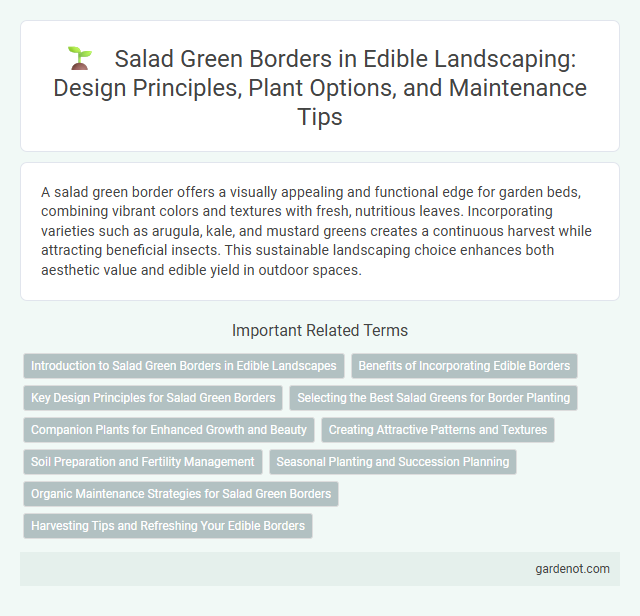A salad green border offers a visually appealing and functional edge for garden beds, combining vibrant colors and textures with fresh, nutritious leaves. Incorporating varieties such as arugula, kale, and mustard greens creates a continuous harvest while attracting beneficial insects. This sustainable landscaping choice enhances both aesthetic value and edible yield in outdoor spaces.
Introduction to Salad Green Borders in Edible Landscapes
Salad green borders are a versatile and attractive component of edible landscapes, providing both aesthetic appeal and fresh produce. These borders typically include a variety of leafy greens such as lettuce, arugula, spinach, and kale, which thrive in well-drained soil with ample sunlight. Incorporating salad greens into garden edges not only maximizes space but also supports sustainable gardening practices by reducing waste and encouraging seasonal harvesting.
Benefits of Incorporating Edible Borders
Incorporating salad green borders into edible landscapes enhances biodiversity by attracting pollinators and beneficial insects, which improves overall garden health. These borders provide a continuous supply of fresh, nutrient-rich greens, promoting sustainable harvesting and reducing grocery costs. By utilizing edible borders, gardeners maximize space efficiency while creating aesthetically pleasing, functional garden edges.
Key Design Principles for Salad Green Borders
Salad green borders should prioritize plant variety, incorporating diverse leafy greens like arugula, kale, and mustard greens to enhance flavor and nutrition. Proper spacing ensures optimal air circulation and sunlight exposure, reducing disease risk and promoting healthy growth. Integrating companion planting with herbs such as basil or chives improves pest control and soil fertility in the edible landscape.
Selecting the Best Salad Greens for Border Planting
Selecting the best salad greens for border planting involves choosing varieties that are both visually appealing and resilient, such as red leaf lettuce, arugula, and baby spinach. These greens offer vibrant colors and textures that create an attractive edible landscape while thriving in sun to partial shade conditions. Opting for fast-growing, easy-to-harvest greens ensures a continuous supply of fresh salad ingredients and enhances the functional beauty of garden borders.
Companion Plants for Enhanced Growth and Beauty
Salad green borders thrive when paired with companion plants like marigolds and nasturtiums, which deter pests and attract beneficial pollinators, enhancing growth and aesthetic appeal. Herbs such as basil and chives improve flavor profiles and provide natural pest control, creating a harmonious ecosystem within the edible landscape. Incorporating flowering companions enriches biodiversity, supports soil health, and transforms salad borders into vibrant, productive garden features.
Creating Attractive Patterns and Textures
Salad green borders enhance edible landscapes by incorporating a variety of leafy greens such as arugula, kale, and Swiss chard to create visually appealing patterns and textures. The contrasting colors and leaf shapes provide dynamic edges that invite harvesting while maintaining aesthetic appeal. Selecting salad greens with diverse growth habits and hues maximizes both functionality and design in garden borders.
Soil Preparation and Fertility Management
Rich, well-drained soil with a pH between 6.0 and 7.0 is essential for a thriving salad green border, supporting nutrient uptake and root development. Incorporate organic matter such as compost or aged manure to enhance soil fertility, structure, and moisture retention. Regularly apply balanced fertilizers high in nitrogen to promote lush, tender foliage while avoiding excessive salts that can damage delicate salad greens.
Seasonal Planting and Succession Planning
Salad green borders thrive with seasonal planting by alternating cool-season greens like arugula and spinach in early spring and fall, and heat-tolerant varieties such as mache and sorrel in summer. Succession planning ensures continuous harvest by staggering sowing dates every two to three weeks, maintaining a steady supply of fresh salad greens throughout the growing season. Incorporating companion plants like edible flowers and herbs enhances biodiversity while maximizing space efficiency in the edible landscape.
Organic Maintenance Strategies for Salad Green Borders
Salad green borders thrive with organic maintenance strategies that emphasize natural pest control, soil health, and sustainable fertilization. Utilizing compost teas, mulch layers, and companion planting supports nutrient-rich soil and reduces weed growth, enhancing the vigor of leafy greens. Regular crop rotation and integrated pest management techniques ensure robust, chemical-free growth for a productive edible landscape.
Harvesting Tips and Refreshing Your Edible Borders
Harvest salad green borders early in the morning when leaves are crisp and full of moisture to maximize flavor and nutrient content. Regularly trim outer leaves to encourage continuous growth and prevent overcrowding, ensuring a fresh and abundant harvest. Refresh edible borders by rotating crops seasonally and enriching soil with organic compost to maintain vibrant, healthy plants throughout the growing cycle.
Salad green border Infographic

 gardenot.com
gardenot.com